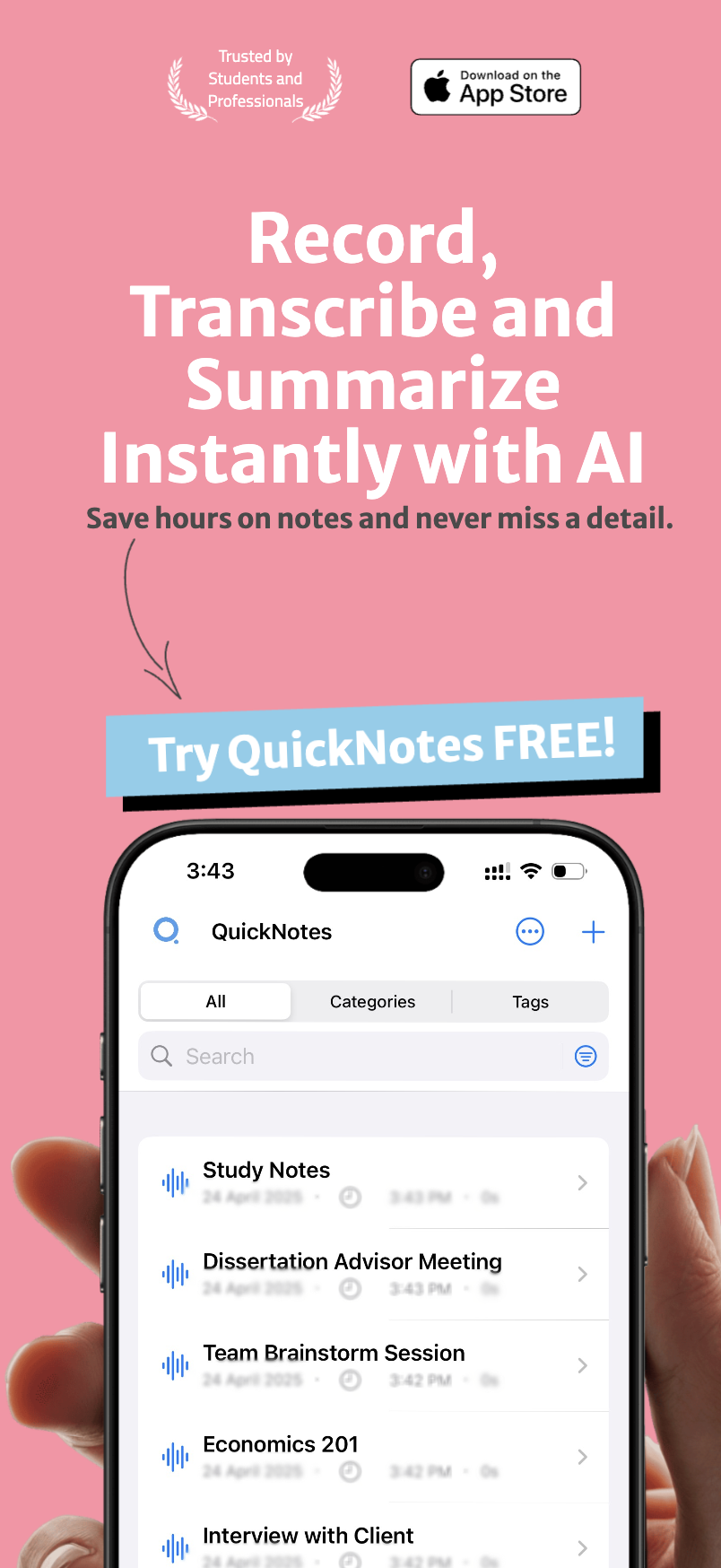If you're like most students, you probably spend hours highlighting textbooks, re-reading notes, and reviewing material you hope to remember for exams. It feels productive, but research shows these passive study methods are actually among the least effective ways to learn. What if there was a study technique proven to dramatically increase retention while potentially cutting your study time in half?
Table of Contents
- What is Active Recall?
- The Science Behind Active Recall
- How to Implement Active Recall in Your Study Routine
- 1. Transform Notes into Questions
- 2. Create Concept Maps from Memory
- 3. Practice the Feynman Technique
- 4. Use Flashcards Effectively
- Digital Tools to Enhance Active Recall
- Smart Note-Taking Apps
- Spaced Repetition Systems
- Knowledge Mapping Tools
- Common Challenges and Solutions
- Challenge: "Active recall feels difficult and uncomfortable."
- Challenge: "I don't have time to create all these questions."
- Challenge: "I get discouraged when I can't recall something."
- Integrating Active Recall with Other Study Techniques
- Spaced Repetition
- Interleaving
- Dual Coding
- A Sample Active Recall Study Plan
- Conclusion: Make the Switch to Active Learning
- You Might Also Like
Enter active recall—the study technique cognitive scientists consistently rank as the most effective way to commit information to long-term memory. Despite overwhelming evidence supporting its effectiveness, it remains underutilized by most students. Let's change that.
What is Active Recall?#
Active recall is a learning principle that involves actively stimulating your memory during the learning process. Rather than simply re-reading or reviewing information (passive learning), active recall requires you to retrieve information from your memory without looking at the source material.
In simplest terms: instead of re-reading your notes, you close your book and ask yourself, "What did I just learn?" This act of retrieval—pulling information from your memory rather than just recognizing it—strengthens neural pathways and significantly improves long-term retention.
The Science Behind Active Recall#
The power of active recall isn't just anecdotal—it's backed by decades of cognitive science research:
- A landmark study by Karpicke and Roediger (2008) found that students who used active recall remembered about 80% of material after a week, while those using passive methods remembered only about 50%.
- Research from Purdue University demonstrated that students using active recall performed 50% better on exams than those using passive study methods.
- Studies show that the more difficult the retrieval practice, the stronger the memory formation—a phenomenon known as "desirable difficulty."
The reason active recall works so well is that it directly strengthens the exact mental pathways you'll need to access during a test. While passive review might help you recognize information, active recall trains you to retrieve it—which is precisely what you need to do during exams.
"The testing effect is one of the most robust findings in learning science. Simply trying to retrieve information strengthens memory far more than additional study of that information." — Dr. Robert Bjork, Distinguished Research Professor of Psychology at UCLA
How to Implement Active Recall in Your Study Routine#
1. Transform Notes into Questions#
One of the simplest ways to implement active recall is to convert your notes into questions. For example, instead of writing "The three branches of government are executive, legislative, and judicial," write "What are the three branches of government?"
When reviewing, look at the question, attempt to answer it completely from memory, and then check your answer. This simple change transforms passive review into active retrieval practice.
I've found that QuickNotes makes this process particularly efficient with its organizational capabilities. I can record my questions and answers, categorize them by topic, and use tags to further organize the content. This makes self-testing streamlined and organized when reviewing for exams.
2. Create Concept Maps from Memory#
After studying a topic, close your books and try to draw a concept map connecting the main ideas and their relationships. This forces you to retrieve and organize information, strengthening both recall and comprehension.
Start with the central concept, then branch out to related ideas, examples, and applications. Check your completed map against your notes to identify gaps in your understanding.
3. Practice the Feynman Technique#
Named after Nobel Prize-winning physicist Richard Feynman, this technique involves explaining a concept in simple language as if teaching it to someone else. If you can't explain it clearly, you haven't truly learned it.
Steps:
- Choose a concept
- Explain it in simple terms (as if to a 12-year-old)
- Identify gaps in your explanation
- Review your sources to fill those gaps
- Simplify and use analogies to strengthen understanding
I've started recording my Feynman explanations as audio recordings in QuickNotes, which allows me to listen back to them later and identify areas where I stumbled or used vague language. The app's transcription feature converts my spoken explanations to text, and the AI-powered summary feature then helps me pinpoint the key areas I need to review further.
4. Use Flashcards Effectively#
Flashcards are perhaps the most well-known active recall tool, but many students don't use them optimally. To maximize their effectiveness:
- Keep cards simple—one concept per card
- Include images where relevant (dual coding enhances memory)
- Test yourself in both directions
- Use spaced repetition (review cards at increasing intervals)
- Don't just memorize definitions—apply concepts to examples
This method divides your notes into three sections: notes, cues, and summary. The "cues" column is perfect for active recall questions that you can use to test yourself later.
After class:
- Review your notes
- Create questions in the cue column that can only be answered if you understand the material
- Cover your notes and try to answer each question
- Write a summary at the bottom of the page in your own words
Digital Tools to Enhance Active Recall#
While active recall can be implemented with just pen and paper, digital tools can make the practice more efficient and effective:
Smart Note-Taking Apps#
Apps like QuickNotes are game-changers for active recall. The ability to record audio, get accurate transcriptions, and organize information with categories and tags makes implementing retrieval practice seamless. I particularly value how QuickNotes allows me to search across all my recordings and transcripts, helping me quickly find related concepts and build a more interconnected understanding of complex topics.
Spaced Repetition Systems#
Spaced repetition is the perfect complement to active recall. By reviewing information at increasingly longer intervals, you can maximize retention while minimizing study time. Many digital flashcard apps now incorporate spaced repetition algorithms to optimize your review schedule.
Knowledge Mapping Tools#
Digital concept mapping tools allow you to create, save, and iteratively improve visual representations of your knowledge. Creating these maps from memory is an excellent active recall exercise.
Common Challenges and Solutions#
Challenge: "Active recall feels difficult and uncomfortable."#
Solution: This discomfort is actually a sign that it's working! The "desirable difficulty" of retrieval practice is what makes it so effective. Start with easier questions to build confidence, then gradually increase difficulty. Remember, every time you struggle to recall something, you're strengthening those neural pathways.
Challenge: "I don't have time to create all these questions."#
Solution: Creating questions as you take notes (rather than afterwards) can save time. Also, consider using QuickNotes to record your study sessions and then review the AI-generated summaries to identify key concepts to focus on. I've found this reduces my prep time significantly while still providing quality retrieval practice material.
Challenge: "I get discouraged when I can't recall something."#
Solution: Remember that the struggle is where the learning happens. When you can't recall something, don't immediately look up the answer—try to remember related information or work through it logically first. This deeper processing enhances learning, even if you ultimately need to check your notes.
Integrating Active Recall with Other Study Techniques#
Active recall works best when combined with other evidence-based learning strategies:
Spaced Repetition#
Instead of cramming, space out your active recall sessions over time. Research shows that spacing out retrieval practice leads to much stronger long-term retention than massed practice (cramming).
Interleaving#
Rather than studying one topic intensively before moving to the next, interleave your practice by mixing up different topics or problem types. This forces your brain to work harder to retrieve the correct approach, leading to better discrimination between concepts.
Dual Coding#
Combine verbal information with visual representations. When practicing active recall, try to retrieve both the verbal explanation and the visual representation of a concept.
A Sample Active Recall Study Plan#
Here's a weekly study plan that incorporates active recall for a typical college course:
- Day 1 (After lecture): Record lecture audio with QuickNotes, then use the transcription and summary features to identify key concepts and convert them to question format
- Day 2: First active recall session—attempt to answer all questions without looking at notes
- Day 4: Practice explaining key concepts out loud (Feynman Technique), recording explanations in QuickNotes for later transcription and review
- Day 6: Create concept maps from memory, then compare to your QuickNotes summaries to identify gaps
- Day 8: Second active recall session with your question list
- Day 12: Comprehensive review using all active recall methods
This spaced approach ensures multiple retrieval attempts at increasing intervals, maximizing long-term retention while actually reducing total study time.
Conclusion: Make the Switch to Active Learning#
If you're still relying primarily on highlighting, re-reading, and passive review, it's time to make the switch to active recall. The evidence is clear: active learning strategies dramatically outperform passive ones in terms of retention, understanding, and exam performance.
While it may feel more challenging initially, active recall actually becomes more efficient over time—you'll learn more in less time, with better long-term retention. That initial investment in changing your study habits will pay dividends throughout your academic career and beyond.
To get started, choose just one active recall technique from this article and implement it in your next study session. Pay attention to how it affects your learning and retention. Once you experience the benefits firsthand, you'll be motivated to incorporate more active learning strategies into your routine.
And remember, digital tools like QuickNotes can make implementing active recall significantly easier. The app's ability to record audio, transcribe content, generate summaries, and organize your notes with categories and tags all in one place streamlines the process and helps you focus on what matters most—the learning itself.
Your future self—the one acing exams while studying less—will thank you for making the switch to active recall.
You Might Also Like#

AI-Powered Summarization: Extract Key Insights Instantly
Learn how QuickNotes' AI summarization technology helps you extract key insights from lengthy recordings and transcriptions, saving time and improving information retention.

Organization and Tagging: A System for Effective Information Management
Learn how QuickNotes' powerful organization and tagging system helps you categorize, find, and utilize your notes and recordings effectively.

Multi-Language Transcription: Breaking Down Communication Barriers
Discover how QuickNotes' multi-language transcription capabilities can break down communication barriers and streamline global collaboration.

